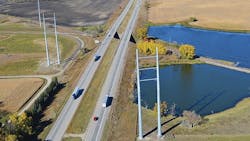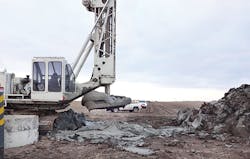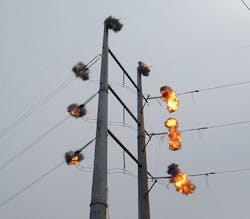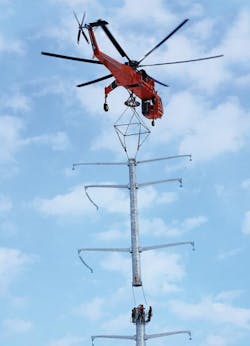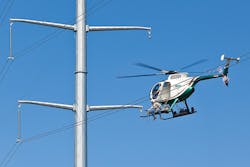CapX2020: Getting It Right
Every once in a while there is an opportunity to do something exceptional. Such a rare opportunity presented itself on a CapX2020 project stretching between Fargo, North Dakota, and Monticello, Minnesota. CapX2020 is a joint initiative of 11 U.S. utilities in Minnesota, North Dakota, South Dakota and Wisconsin. The utilities’ goal is to upgrade and expand the grid to ensure continued reliable service well into the future and to expand access to new generation, including renewable energy. The last major bulk transmission upgrade to the upper Midwest’s electric transmission grid took place about 40 years ago.
The nearly 800 miles (1288 km) of CapX2020 projects consist of four 345-kV transmission lines connecting all four states, a 230-kV line across northern Minnesota and at least 20 substation improvements at an overall cost of more than US$2 billion. One of the four CapX2020 projects is the 345-kV Fargo-Monticello transmission project, which was completed in April 2015. Xcel Energy built 240 miles (386 km) of 345-kV line in three phases. Xcel Energy, the project’s lead utility, used its staff to design the first two phases of the project: 28 miles (45 km) of phase 1 between Monticello and St. Cloud, and 78 miles (126 km) of phase 2 between St. Cloud and Alexandria.
To design the 134 miles (216 km) of phase 3 between Alexandria and Fargo, Xcel Energy engaged POWER Engineers to serve in a number of roles for CapX2020, including overall owner’s engineer. Many transmission projects often run about 30 miles (48 km) or less and include only a handful of structures. Such projects do not offer much of a chance to grab value from studies that question assumptions and test alternatives. However, Xcel Energy saw a potential for repeated savings on its CapX2020 projects. Phase 3 alone included more than 750 structures. Saving $1000 on each structure adds up to real cost savings. And studies for value engineering, reliability and maintenance, and reducing risk offered a chance to save considerably more.
Engineering Studies
The potential for cost savings became apparent on the northernmost 52 miles (84 km) of phase 3. Today, this area is mostly farmland, but about 8500 years ago, it formed the bottom of an immense glacial lake. As the ancient lake dried out over the millennia, the lakebed’s upper surface down to about 15 ft (5 m) formed a stiff clay layer that is exceptional for crops.
Below that crust formed an area of soft fat clay deposits up to 100 ft (30 m) deep that have the consistency of soft peanut butter. These clay deposits can create problems for drilled pier foundations used for self-supporting tubular steel poles. The tubular steel poles need a deep foundation for stability; otherwise, ice and wind conditions in the region can cause the poles to tilt over time.
Because of the geologic features and strong design wind loads, Xcel Energy initially believed structure foundations would have to be driven piles with concrete pile caps and stems. Xcel Energy also recognized substantial cost savings could be achieved if drilled piers were used instead of driven piles. Xcel Energy foundation crews could install drilled piers themselves, eliminating the need to employ specialty contractors. Drilled piers would save time because one foundation crew could install about 10 drilled piers in a week, whereas specialty contractors would need about four weeks to install a single pile foundation.
For these reasons, Xcel Energy studied intensively whether it could use drilled piers instead of driven piles. Xcel Energy tapped POWER Engineers, Northern Technologies Inc. (NTI) and its own construction staff to help. NTI’s geotechnical studies contained a comprehensive soil investigation, including pressure meter testing. POWER Engineers compared preliminary engineering and costs for drilled pier and driven pile foundations. Xcel Energy’s construction team built and evaluated full-scale test foundations. The tests also measured productivity to set a baseline for the project schedule.
The studies proved successful. They showed it was possible to use drilled piers instead of driven pile foundations as long as certain precautions were taken. A finite element analysis by an independent foundation design consulting firm validated the results.
Shield Wire
Each part of the project offered different assumptions to check. For example, Xcel Energy had planned phase 2, running from St. Cloud to Alexandria, as a double circuit but with only one circuit being installed; the second circuit would be added later. Original plans were to install an optical ground wire (OPGW) on one side of the davit arms and steel shield wire on the other. However, with only one circuit being installed initially, this raised questions about the need for both OPGW and steel shield wire.
Lightning and short-circuit fault current studies showed OPGW could shield the initial line from lightning while providing a path for internal and third-party telecommunications. This eliminated the need for steel shield wire for the first circuit installation, deferring the cost of the steel shield wire until the second circuit is installed. The short-circuit fault-current studies also showed Xcel Energy could go with an OPGW cable of a smaller size in certain segments of the line. By re-evaluating the purpose of the original design, Xcel Energy saved on material and installation costs.
Line Performance
North Dakota, South Dakota and Minnesota rank among the top seven states in the U.S. for wind energy potential. One of the purposes of the CapX2020 initiative is to help harvest this potential energy by tapping into power generated by the region’s wind turbines. However, the same wind that turns those giant turbine blades can create problems for transmission lines and towers. Add in the region’s sometimes cold, harsh winters and there are a lot of physical stressors.
When the wind blows across davit arms, for example, they vibrate. This poses the potential for stress cracks on welds. On the Fargo project, davit arms to support two circuits were installed even though only one circuit was built initially. These were big custom-designed davit arms, and installing them up front would save time and trouble later. Generally, adding weight to the davit arm dampens vibrations. In this case, vendors and other experts could not agree on the right amount of weight to add. Finite element modeling provided one answer, but it was hard to model how the bolted connection of the arm on the pole really behaved.
The issue called for more study. Xcel Energy engaged Braun Intertec and ESI Engineering, which specialize in structural vibrations, to take a look. As part of a field study on an actual structure installed on a foundation (prior to stringing), they placed accelerometers on davit arms and then struck the arms with an instrumented energy hammer to measure the vibration effects and damping characteristics of each arm design in place. No other calculation or finite element model can be closer than this detailed field test, and the results were invaluable.
An analysis of the findings showed the amount of weight needed to dampen vibrations depended on the structure, length and thickness of the arm, as well as the material of which it was made. Some of the thicker arms dampened vibrations without any added weight. By grouping the structures into families — or types — based on these differences, Xcel Energy saved on the option of putting up the heaviest weight on each of the four davit arms of 750 structures.
Galloping
The region’s strong winds and winter storms could combine to create a problem for transmission lines. During a storm, ice can build up on one side of a wire. Gravity sculpts the ice until ice and wire take on the profile of an airplane wing. On a windy day, the conductor pretty much behaves like an airplane wing, responding with lift and drag. This is called galloping, and it can be quite destructive.
Line segments of the CapX2020 Brookings project located in west central Minnesota actually had experienced galloping during construction. Xcel Energy backed a weather study for the Fargo project to analyze this risk. POWER Engineer’s geographic information system team mined Internet weather data stations for temperatures, precipitation, and wind direction and speeds over time. The studies revealed which segments of the Fargo line were most prone to galloping. Instead of installing thousands of anti-galloping devices (interphase spacers) along the entire transmission line to control potential galloping, now only hundreds were needed. After a year of operation, no galloping issues have been observed.
Helicopters
Even good weather sometimes presented problems for construction crews and schedules. As temperatures warmed and snow melted in the spring, for example, some project areas flooded and water saturated the ground. Soft soil could keep crews and their heavy trucks out of work areas for weeks and weeks. This would mean lost time.
Using helicopter crews provided a solution for meeting schedules and early completion, but it increased line construction costs. The utility used helicopters to string lead line for stringing conductor as well as to install conductor accessories such as line spacers. Helicopters also were used to shuttle linemen to conductor arms for conductor attachment work.
Balancing project schedules and costs between ground and helicopter line crews required a lot of studies on different types of tasks at different times of the year and at different costs. A great deal of effort went into intricate spreadsheets to estimate costs, including potential damage to crops, and to reduce the risk of delays. With these studies in hand, Xcel Energy was able to show contractors how best to divide work between helicopter and ground crews for projects in winter, spring, summer and fall.
To ensure helicopter operations remained safe, Xcel Energy called on Utilities Aviation Specialists. The consulting firm provided guidance on contract line specifications for helicopter use during construction, safety auditing of work and equipment, specialized training and safety management. Adding another eye qualified in aviation practice on all the helicopter operations added some costs but greatly reduced the risk of accidents.
Final Savings
Utilities, like people, can get used to operating in familiar ways. CapX2020’s major upgrade to the upper Midwest’s electric transmission grid afforded Xcel Energy the unique opportunity to undertake studies to ensure it was doing the right things in the right ways at the right times. Those studies proved their value by enabling Xcel Energy to find repeated savings over hundreds of structures, ultimately saving the utility $15 million on phase 3 between Alexandria and Fargo, and $22 million over all phases of the project.
Gerald Chezik is a retired project manager from Xcel Energy. He was responsible for the overall design and construction phase of the CapX2020 Fargo-Monticello project. His experience includes transmission line design and transmission project management as well as transmission engineering and construction, and quality project management.
Aaron Boston is a project manager at POWER Engineers and an experienced project engineer for transmission line projects. He is responsible for design criteria, line modeling and design as well as structure analysis and design. In addition to overseeing design activities for transmission lines, he also provides project management on numerous projects.
